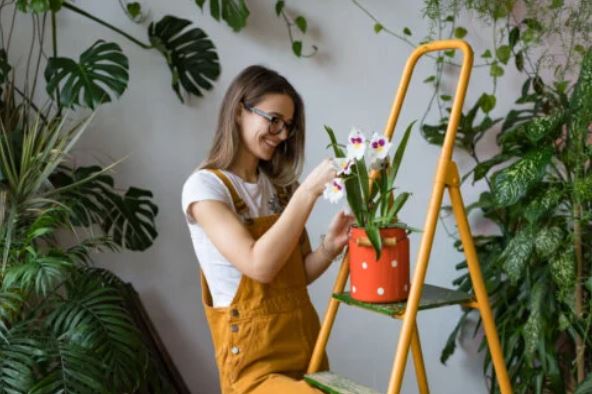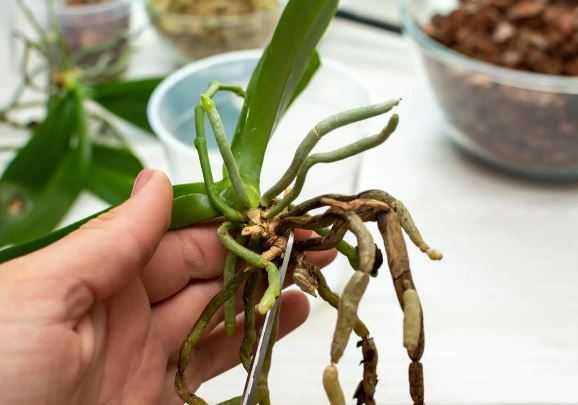Moving orchids from one pot to another is not done lightly. If you want it to turn out well and a healthy plant to decorate your home, take note of the secrets that we will reveal.

Sophisticated and elegant, that’s how orchids are. These plants flourish in gardens and also shine inside the house, being part of the decoration. As specified by the American Orchid Society, the family is large and is made up of thousands of Orchidaceae species. Now, to transplant orchids correctly you have to take certain precautions.
They are characterized by the delicacy of their leaves with complex formations, the flowers of bilateral symmetry and the various sizes, as well as the aroma. According to the copy will be the deal.
Step by step: how to transplant orchids
Transplanting orchids from one pot to another involves peculiarities, such as the materials to be used, the container in which they will be planted and even the right time of year to do so. Next we will detail the task.
1. Clean the instruments
Have you ever heard that plants are treated like humans? It is not just a saying. Like anyone, orchids are prone to disease in the middle of transplantation.
To avoid this, your hands and utensils have to be disinfected and in good condition. It is advisable to use alcohol for the instruments and gloves when you touch the roots.
2. Prepare the pot, drain and substrate
As it is a transplant, it is linked to the growth of the plant. Make sure the new pot has more space. It can be a reusable pot, but wash it well and remove any soap residue.
What follows is to prepare the compound. Although they sell ready substrate, if you want your own recipe mix the elements based on the amount you require for the new pot.
As for drainage, opt for those that do not retain moisture. Expanded clay balls are an example. Hot water is added to the substrate in order to remove dust and hydrate it before transplanting.
eye! The mixture should rest for a few hours to be well hydrated. As it happens, move on with the rest of the process.

Orchids gracefully decorate interiors. You can transplant to pots to place in your home.
3. Remove the orchid from the pot
It is a delicate step, since any mistake would damage the roots. With your hand you hold the plant and dump it in the new container.
You will notice that the substrate will come off, but it is likely that some roots are so attached that, to loosen them, you will have to water them for a while by immersion.
4. Eliminate diseased roots
This is the way to sanitize the plant. Outside the pot you check for affected or dead roots and prune those that are in poor condition as close to the base. Suture in what you cut using cinnamon or charcoal powder.
5. Transplantation of orchids
Part of the substrate goes to the bottom of the vessel. In the center you place the orchid and continue filling. Try not to compact with your fingers; instead, lateral blows to the vessel are preferable.
In this step it is essential to create a base layer of substrate, the size of which will depend on how tall the pot is. It is recommended that the aerial part is at the height of the edge and that the roots are submerged in the substrate.
6. Wait a week to water
The right thing to do is wait a week, as sanitation cuts are powerful sources of disease for the plant if they receive water immediately.
Tips for caring for an orchid
As we discussed at the beginning, orchids feel like a person. Among its basic care, irrigation from time to time stands out. Other tips are as follows:
Select the ideal site: especially since there are so many types of orchids. Make sure that the sun’s rays reach the area indirectly.
Always fertilize it: find the appropriate fertilizer for your plant, so that it does not lack nutrients and vitamins. Fertilizers are sold in bags or sachets.
Cut when necessary: that is, the moment it stops blooming completely. Do it from the stem, before it turns yellowish.
Protect them at the right temperature: they can’t stand the cold. The suggestion is to place them in an area below 30 ºC and with a minimum of 9 ºC. In case of living in a dry environment, it is a good alternative to place a humidifier.
Transplant at the precise time: in general, every 2 years is recommended.
Hydrate it with special water: it must be low in minerals.
Solving doubts to transplant orchids
You already know how to transplant and care for them. Even so, there are doubts that frequently arise and that we will clarify here.
What substrate is recommended for orchids?
Although they require compound to plant them, some grow epiphytes, that is, on another plant that serves as a support. Consequently, it does not strictly need a substrate to grow. A detailed explanation on epiphytic plants is offered in the article “Vascular epiphytes as bioindicators of forest quality: anthropic impact on their diversity and composition”.
However, there are orchids that do depend on a consistent substrate. In any case, it cannot be the normal one for any garden.
At what time is it appropriate to transplant orchids?
Every plant has a life cycle and it is necessary to know it. Orchids grow par excellence in spring, specifically when temperatures settle. Starting from this point, the transplant that does not harm its growth would be at the end of the winter.
In the same way, it is necessary to change the container if the substrate has compacted and the water does not drain, which would lead to the formation of fungi. Also in the accumulation of mineral salts or bacteria by the different fertilizers.

Orchid roots need special care to prevent diseases from invading the plant.
Why do you recommend that the pots for orchids be transparent?
Many orchids live on tree branches, leaves or rocks and their roots do not penetrate the substrate. It is its epiphytic peculiarity, which we already talked about.
Although some believe that due to this way of life it is not advisable for an opaque pot to cover their roots, because photosynthesis is difficult, the reality of transparent containers is that they facilitate the monitoring of the roots. It is easier to know if they need urgent care.
Golden rules about orchids in the garden
Orchid societies abound in the world. One aspect in which they emphasize is the importance of not changing the conditions in which plants previously lived. If where it is it grows and blooms, do not take it to another place.
If you want to transplant it to a log to beautify your garden, it has to be a species that adapts. Among them are the Vandas, Phalaenopsis or Cattleyas. Don’t go for old logs.
Hold it with strings and not wire. With a mesh (a fabric also works) you hold a little substrate that facilitates the support of the tree. Fungicides help take care of them, because the logs develop their own diseases and could spread to your orchid.





